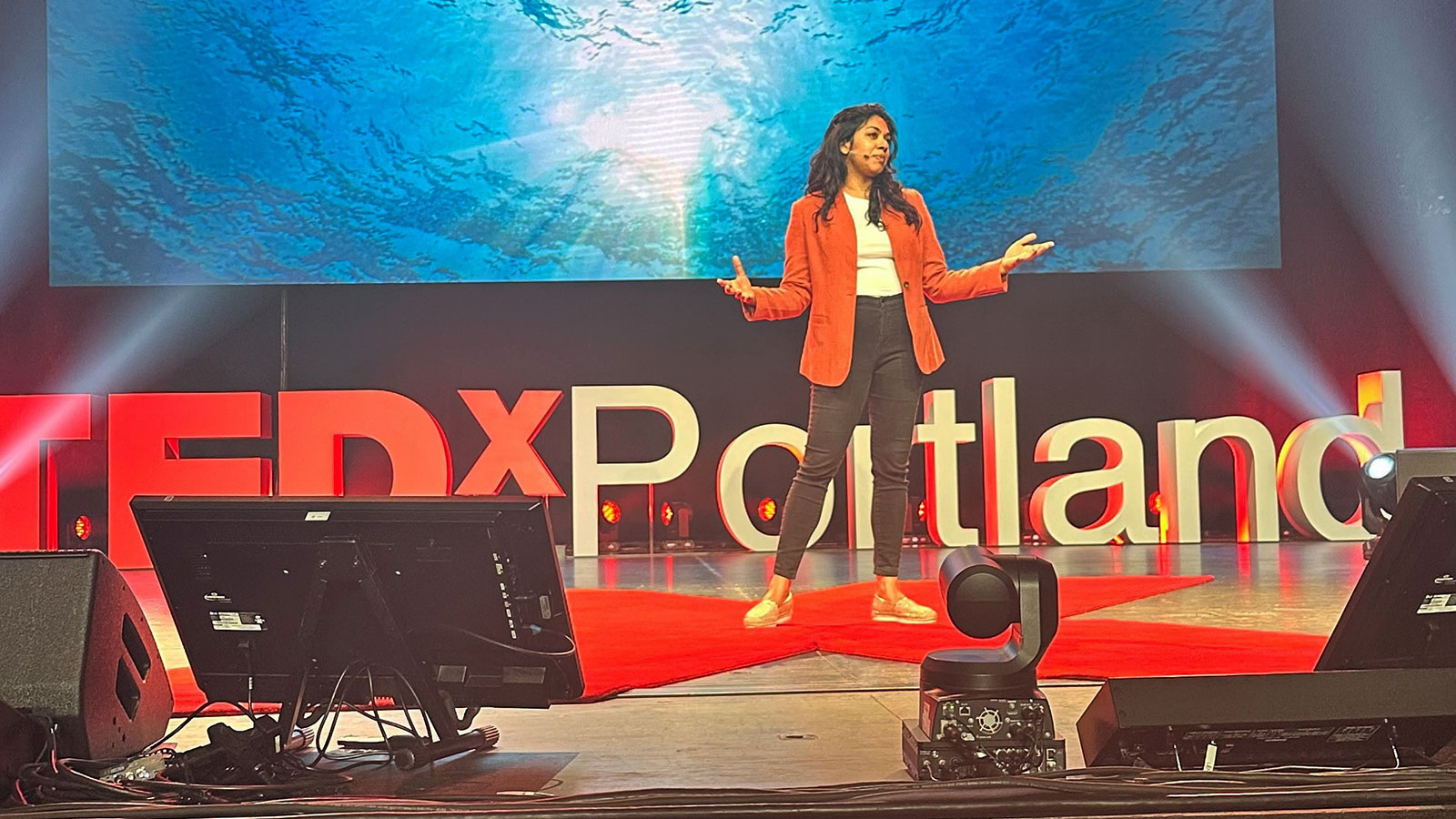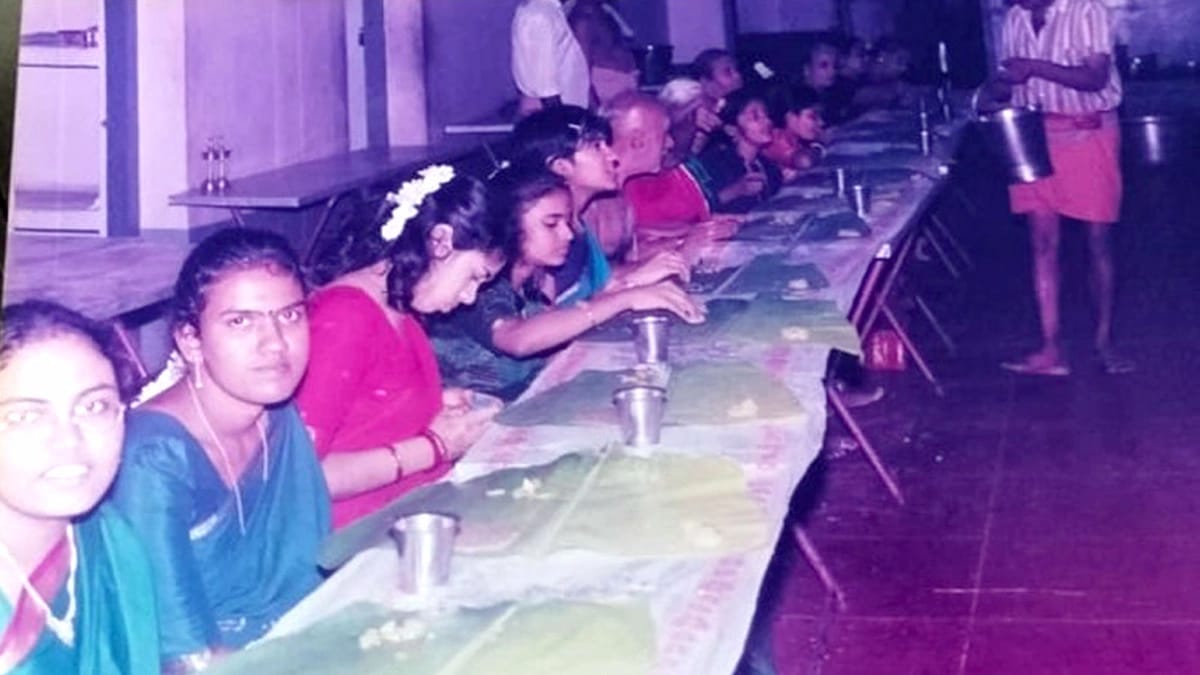TEDxPortland: The Intersection of Climate and Plastics
We can’t solve the climate crisis if we keep drilling more oil for plastic production.

When I took on the role as Ocean Conservancy’s director of climate and plastics initiative, I was determined to be more “out there” in 2023. But be careful what you wish for! I certainly didn’t expect to be sharing a photo of myself as an awkward teenager with 3,000 people on the stage at TEDxPortland—but that’s the thing about telling our stories: We have to tap into what’s real.
Get Ocean Updates in Your Inbox
Sign up with your email and never miss an update.
What brings us to this work and convinces us that change is possible? For me, it’s my grandfather’s 80th birthday in Kerala, India, when I was 14.
I remember how surprised I was to see that a house full of 30 people made maybe two handfuls of garbage at each meal. We ate on banana leaves, with our hands, and drank out of reusable metal cups. We had soda out of refillable glass bottles. I go back to this memory because I think it’s important to hold on to our lived experiences of a world with less plastic. It’s important to remember that wasn’t even 50 years ago—this was in 2000, and more than half the plastic ever made has been made since then.
Plastics are fossil fuels—they’re made using oil, gas and coal, yet we don’t often think about them as part of the climate crisis. But they are, and we can’t solve the climate crisis if we keep drilling more and more oil for plastic production. It’s a disaster for our ocean already: 11 million metric tons of plastics go into the ocean each year, and that number is projected to triple by 2040. That plastic is made from oil—to give you a sense of scale, the oil needed to make those 11 million tons of plastics is about the same amount as 800 Exxon Valdez oil spills, every year. In fact, the world’s largest producer of single-use plastic is, wait for it … Exxon. When we see plastic pollution on the beach, we have to remember the hazardous impacts on human health, too—from chemical pollution at the oil drilling site to petrochemical plants that are causing cancer in surrounding neighborhoods that have replaced coal-fired power plants as some of the biggest newsources of the greenhouse gas pollution that’s warming our planet.

Plastic is so ubiquitous; it’s sometimes hard to imagine that this crisis is new. Plastics production has exploded over the last 20 years because oil companies needed a new market for their products. As electric vehicles (EVs) and renewables cut into demand and fracking created a surplus of oil and gas, they needed a Plan B: plastics. If production continues growing at this current pace, by 2050, we’ll use more oil per person to make plastics than we will to power our cars.
But the plastics industry can sell this to their investors only if we are there as willing customers. The oil and gas industry needs us to believe that the growth in plastics is inevitable. They need us to believe … plastic is a waste problem rather than a problem of overproduction. And conveniently, they put the blame on individual consumers when recycling and waste management fails and when plastics end up in our waterways. That PR campaign is working—our policies have focused for too long on reducing waste rather than dealing with where it comes from. While important, cleanups and recycling alone can’t fix the plastic problem. If we want a future where Big Oil doesn’t turn into Big Plastic, we must get serious about producing less plastic.
We have to stop working toward marginally less waste—we need a system with a lot less plastic.
It’s something we’re doing already in many parts of our oil and gas system. Take cars as an example. From 1985-2005, the average fuel efficiency of the United States car and truck fleet stayed almost flat; car manufacturers lobbied hard to prevent rules and said that consumers wouldn’t want more efficient cars—they couldn’t perform, wouldn’t be safe and EVs couldn’t work. Then California policymakers took a stand to fight climate change and passed regulations for much stricter fuel standards. And then we did it nationally, and a system of cars on a clean electric grid that didn’t need oil became a reality. Systems change.
We can do the same for plastics, but we need policies to make it more than just a PR campaign and affordable for everyone. The good news is it’s starting. A growing number of countries, from India to Canada to Rwanda, have banned some single-use plastics. California passed S.B. 54, which requires a 25% cut in single-use items and requires plastic producers to take responsibility for their products. Over 10 years, that is the same as taking 25 million cars off the road for a year. In France and Germany, even McDonald’s is testing reusable dishes and packaging. And global plastics treaty negotiations are underway. The United States passed a historic package of $350 billion in climate incentives in 2022 with the Inflation Reduction Act, aimed to get us less dependent on oil, gas and coal. But that legislation didn’t include plastics; why?—because our policymakers don’t see plastic as a climate problem.
If we want to solve the plastics pollution crisis for our ocean, our climate and our communities, we have to start by aiming for a system where we produce a lot less plastic—that’s the most important goal if we want to cut emissions, protect human health and reduce plastic waste on our beaches. Everything else flows from that and gets easier: Make less, manage better, clean up. The growth in plastics is a Big Oil play, and we have to do what we’ve already done to Big Oil and traditional fuel sources: make them change. People aren’t causing the plastic climate crisis, companies are, and it’s time we said “Enough”.